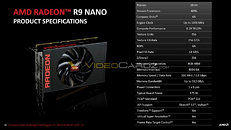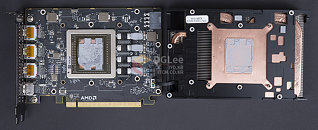Tuesday, August 25th 2015

AMD Radeon R9 Nano Core Configuration Detailed
AMD's upcoming mini-ITX friendly graphics card, the Radeon R9 Nano, which boasts of a typical board power of just 175W, is not a heavily stripped-down R9 Fury X, as was expected. The card will feature the full complement of GCN compute units physically present on the "Fiji" silicon, and in terms of specifications, is better loaded than even the R9 Fury. Specifications sheet of the R9 Nano leaked to the web, revealing that the card will feature all 4,096 stream processors physically present on the chip, along with 256 TMUs, and 64 ROPs. It will feature 4 GB of memory across the chip's 4096-bit HBM interface.
In terms of clock speeds, the R9 Nano isn't too far behind the R9 Fury X on paper - its core is clocked up to 1000 MHz, with its memory ticking at 500 MHz (512 GB/s). So how does it get down to 175W typical board power, from the 275W of the R9 Fury X? It's theorized that AMD could be using an aggressive power/temperature based clock-speed throttle. The resulting performance is 5-10% higher than the Radeon R9 290X, while never breaching a power target. Korean tech blog DGLee posted pictures of an R9 Nano taken apart. Its PCB is smaller than even that of the R9 Fury X, and makes do with a slimmer 4+2 phase VRM, than the 6+2 phase VRM found on the R9 Fury X.
Sources:
VideoCardz, IYD.kr
In terms of clock speeds, the R9 Nano isn't too far behind the R9 Fury X on paper - its core is clocked up to 1000 MHz, with its memory ticking at 500 MHz (512 GB/s). So how does it get down to 175W typical board power, from the 275W of the R9 Fury X? It's theorized that AMD could be using an aggressive power/temperature based clock-speed throttle. The resulting performance is 5-10% higher than the Radeon R9 290X, while never breaching a power target. Korean tech blog DGLee posted pictures of an R9 Nano taken apart. Its PCB is smaller than even that of the R9 Fury X, and makes do with a slimmer 4+2 phase VRM, than the 6+2 phase VRM found on the R9 Fury X.


101 Comments on AMD Radeon R9 Nano Core Configuration Detailed
AMD disabled AF for a reason, not on a whim. Benchmarking AF isn't usually done in reviews because it's generally an automatic check-boxed image quality setting. The only one I managed to find that is relatively recent (i.e. comparing the impact on GCN) is HardOCP's Watch Dogs performance review
Nvidia GTX 780 Ti - virtually no penalty......................................................................................................................................AMD R9 290X ~ 6% performance hit
I'm pretty sure that AMD worked out the optimal settings to best showcase their product - and leaving AF disabled seems to one of them. If it were inconsequential, I'm sure they would have left enabled as most reviewers and users would.
By jove, it did. www.extremetech.com/computing/51994-the-naked-truth-about-anisotropic-filtering/3
They show that even in 2002 we could do math. What a revelation. Seriously though, please check what you are about to say prior to making blanket statements. If professor google can prove you wrong that fast then maybe you should slow down a tiny bit.
The article, in summary, is old. The tested cards demonstrate x16 AF causing between 50% and 6% drops in frame rate with older hardware. Conversely, this is utilizing games where the draw distance and resolution are much smaller. It could therefore be reasonably approximated that AF is likely to have somewhere between a 1% and 25% (resolution bumps up to 1920x1080 as a standard, but 13 years of gaming is about 8 generations of cards) impact on performance, depending upon resolution, draw distance, level of AF, and available hardware. Assuming that your game was running as 60 FPS, that's between 1 and 15 FPS. Sorry, but that's not a negligible impact.